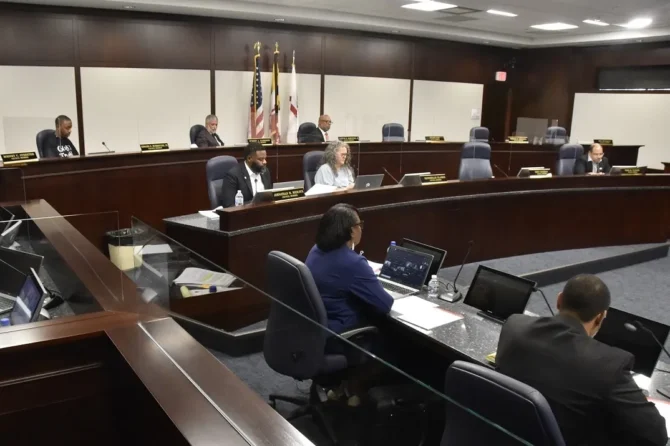MARYLAND MATTERS: As Maryland continues to implement a decade-long education reform plan, the focus of multiple state boards and commissions has shifted to a key initiative: ensuring that all students are college and career ready.
Part of the focus is to reconsider how “college and career readiness” is defined, something the State Board of Education is considering. That process is ongoing as other boards and commissions are focused on dramatically expanding apprenticeship opportunities for juniors and seniors in high school.
Defining readiness
The State Board of Education recently held a discussion focused on college and career readiness, one of the main priorities of the multi-billion-dollar Blueprint for Maryland’s Future education reform plan.
The American Institute of Research based in Arlington, Virginia, offered a few recommendations to revise the “college and career readiness standards,” or CCR, within the Blueprint plan.
One would be to take a student’s grade-point average into account when determining readiness: if a student’s GPA is 3.0 or higher by the end of 10th grade, they would be counted as meeting the standard.
Currently, the Blueprint law states students “meet or exceed” the standard based on standardized test scores.
According to a summary of the institute’s study based on Maryland students from cohorts between 2017 and 2021, about 40% met the readiness standard at the end of 10th grade. When the institute added students’ grade point average of at least 3.0, the percentage increased to 64%.
“It provides more than one option to meet the CCR standard,” said Matthew Duque, director in the department’s Office of Research, Planning, and Program Evaluation. “This is important because it’s not only more inclusive, but it’s also a better predictor of post-secondary success.”
The board plans to hold a virtual public hearing about CCR policy recommendations Nov. 9.
Meanwhile, the state is also looking at another pathway bolster to post-public school success: apprenticeships.
‘More fluidity’
The Blueprint for Maryland’s Future sets a goal to increase the number of apprenticeships for high school juniors and seniors to 60,000 in seven years, and to ensure at least 45% of high school students complete a high-school level apprenticeship program by the 2030-31 school year.
That could prove to be a lofty goal.
As of 2021, a report by a Career and Technical Education Committee shows nearly 4,100 graduates from the state’s 24 school systems completed a youth apprenticeship or earned an industry-recognized credential. About 60,000 students graduate from Maryland’s public schools annually.
Meanwhile, the Blueprint’s Accountability and Implementation Board approved a career and technical education plan Oct. 19 that includes the apprenticeship goals.
A chart within the 85-page document shows the percentage of high school students in 2021 that received an industry credential or completed youth apprenticeship programs.
Worchester County had the highest percentage of students that received an industry credential at 32%. Four other school districts achieved at least 20%:
- Kent at 26.3%
- Somerset at 25.8%
- Dorchester at 22.3%
- Harford at 21.6%
However, eight school districts recorded 5% or less, including Allegany (5%), Anne Arundel (3.7%), Prince George’s (3.2%) and St. Mary’s (0.5%).
Garrett County public schools recorded the lowest at 0%.
Between 2017 to 2021, more than half of Maryland’s high school graduates attended two-year or four-year colleges and universities the same year after completing four years of high school.
Jacob Hsu, a member of the board of directors with the technology firm Catalyte in Baltimore, said “more fluidity” is needed to balance college and career readiness.
“When you go to most high schools, there isn’t a focus on career readiness. Just college readiness,” said Hsu, a former CEO of Catalyte. “Apprenticeships aren’t just for kids who aren’t college bound. It should be an ‘and’ and not an ‘or.’”
‘Who doesn’t want to get paid to learn?’
Josh and Lauren Martin are offering apprenticeships for high school students at Seaside Plumbing Inc. in Worcester County. Lauren Martin is a certified public accountant and Josh Martin is a master plumber.
Lauren Martin said in an interview that the company with 75 employees brought in two high school seniors who traveled with a senior technician to various jobs last school year.
After they graduated, Martin said the students returned to Seaside Plumbing and became full-time assistant technicians. A key part of the job is continuing education: classroom instruction once a week to learn how to maintain water heaters, install sump pumps and other aspects of the plumbing industry.
Two new high school seniors are with Seaside this school year, Martin said. One student comes every Saturday and the other student works a half-day. While the main aspect of the job is to ride with a technician to learn the plumbing industry, the students also obtain soft skills such as talking to customers and being on time for assignments.
Martin said the recent high school graduates and the two current students receive slightly above the minimum wage. The current state wage is $13.25 per hour for businesses with 15 or more employees. That rate is $12.80 per hour for small businesses. The wage will increase to $15 an hour in January.
“Who doesn’t want to get paid to learn?” asked Martin, who has co-owned the business for 21 years. “The apprentice program is fantastic. I know on the shore we can nail this. We want kids to know there is another option. You can have a career without going to college.”
Apprenticeship 2030
A legislative work group called the Apprenticeship 2030 Commission, created by Senate Bill 104signed into law this year by Gov. Wes Moore (D), is tasked to provide recommendations to implement, assess and improve apprenticeship programs.
Under the new law, the commission “shall focus on registered apprenticeships at all education levels with the goal of recruiting unemployed and underemployed individuals at least 18 years old, as well as high school students, into apprenticeships.”
Hsu serves as chair of the commission, which also includes eight state lawmakers, state and education officials, business leaders and union representatives.
Part of the commission’s responsibilities are identifying the largest occupational sectors with current or projected skill shortages, engaging with employers and labor organizations to assess needs for registered apprenticeship career pathways and exploring apprenticeships in fields that require higher education degrees such as health care, teaching and other public services.
Martin, a member of a national nonprofit organization called Explore The Trades, has a recommendation for the commission: figure out a solution to expand access to tax credits and grants for small business owners.
For instance, she said the average annual salary for a master plumber is $60,000. In addition, she said the average profit margin “after all the overhead” for most trade businesses range between 2% to 5%.
“We are in that range,” she said. “That’s all that’s left at the end of the day to build a work force. That is hard.”
Martin has a commission member who agrees with her: Sen. Mary Beth Carozza (R-Lower Shore).
Carozza said streamlining the process for businesses to receive approval for an apprenticeship program would help.
According to the Apprenticeship Maryland Program, which became established as a pilot program seven years ago, it takes several steps for a business to become registered. Employer applications are reviewed by the state’s Apprenticeship and Training Council. They’re also reviewed and later approved by the Division of Workforce Development and Adult Learning within the state’s Department of Labor.
Carozza said it can take about two months for a business to receive approval for an apprenticeship program.
“We need to tighten up the approval process so the apprenticeships can be approved on a more timely basis,” she said. “I want to make sure that the students that I represent, the employers I represent benefit from this apprenticeship program so we can keep more of our youth talent here on the Eastern Shore.”
The apprenticeship commission is scheduled to convene for a third time Nov. 8 in Annapolis. A report with recommendations is due by Dec. 1.
Apprenticeships will also be discussed Dec. 7 at the Maryland Association of Counties annual winter conference in Cambridge on the Eastern Shore.










